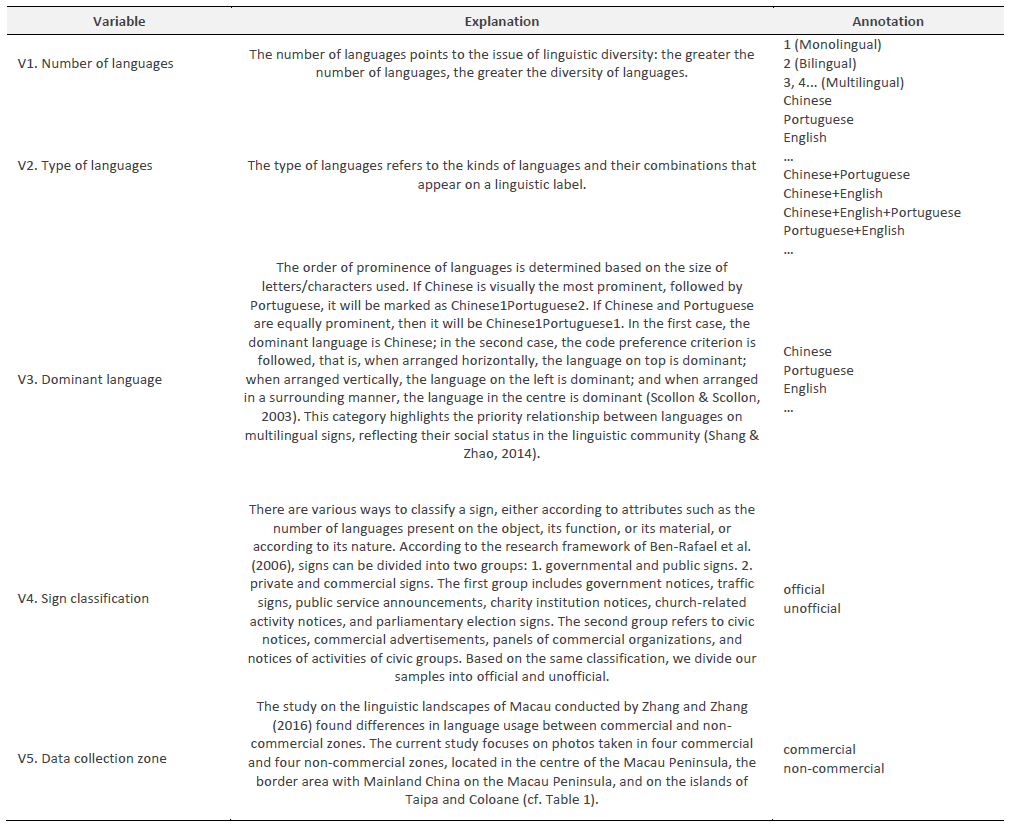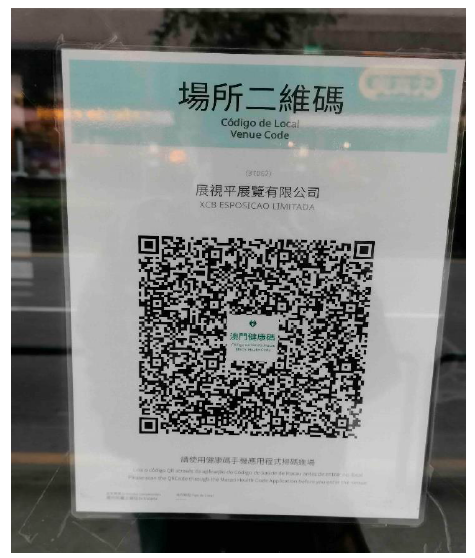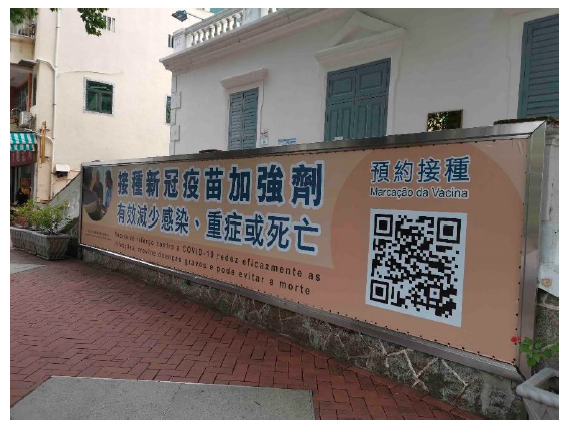Introduction
Macau, situated in southern China, was under Portuguese administration until 20th December 1999. The Basic Law of Macau currently stipulates that both Chinese and Portuguese are official languages in the city. However, it is not specified whether "Chinese" refers to Mandarin Chinese or Cantonese (Yan, 2017). Portuguese remains the predominant language of public administration and the judicial system, although it is not commonly used in the everyday lives of Macau residents. Moreover, Macau is a tourist city, with data from the World Travel and Tourism Council (WTTC) indicating that in 2018, the tourism sector accounted for 72.7% of GDP (Li, 2020). In this context, the significance of English as an international language in Macau is underscored, with the language primarily employed in international trade, financial institutions, and the tourism industry. As indicated by Hu and Chen (2020), the three languages coexist in Macau, each within its specific domains of use.
Conversely, due to its historical and sociocultural peculiarities, Macau attracts not only thousands of tourists from mainland China, Asia, and other parts of the world but also non-resident workers and students from various countries or cities. Consequently, the city's demographic composition is notably diverse, contributing to a setting characterised by multilingualism and multiculturalism. Zhang's (2016) study demonstrates that the linguistic landscape of Macau is characterised by its multilingual nature. In public spaces, three languages are most commonly observed on signs: Chinese, English, and Portuguese, a phenomenon complemented by the presence of other languages, albeit with very limited use. Those who utilise the official languages adhere strictly to the provisions of the Basic Law of Macau, while the use of non-official languages is primarily conditioned by economic factors. This analysis reveals that the Macau government, society, and local inhabitants adopt different approaches and attitudes towards the selection and use of languages in public spaces.
In 2020, the city of Macau faced a challenging situation due to the combined impact of the global pandemic caused by the novel coronavirus (COVID-19) and the city's geographical and humanistic conditions. The high population density accelerated the spread of the virus, increasing the difficulties encountered in disease prevention and control. The structure of the economy, which was heavily dependent on the gambling sector, also heightened Macau's economic vulnerability under the impact of the pandemic (Wang & Liu, 2022). From the outset, the Macau government adhered to the directives of the Chinese central government in implementing pandemic control measures. As reported by Li (2020), Macau implemented a series of stringent border control measures, cancelled major festive events, closed casinos, postponed the start of school terms, and at the height of the crisis, even imposed a stringent lockdown on the city. Concurrently, the dissemination of information related to combating the pandemic was intensified through various media, including television, the internet, and posters. The importance of maintaining social distancing and wearing masks was emphasised. Local organisations and institutions also collaborated with the government to disseminate information about pandemic control measures. This was achieved through the posting of informative posters in private locations, which resulted in the widespread dissemination of announcements, instructions, and guidance on pandemic control throughout the city.
On 26 December 2022, the severity of the pandemic's classification in China was officially changed from "pneumonia" to "infection". Subsequently, the "zero Covid" policies were revoked, and the stringent pandemic control measures, including travel restrictions, were significantly relaxed as of 8 January 2023 (Siu, 2023). At this juncture, Macau initiated a recovery process for tourism following a three-year decline.
The pandemic had a profound and long-lasting impact on the community of Macau, prompting numerous scholars to investigate these effects from a variety of vantage points. It is our contention that a study conducted from the perspective of the linguistic landscape is of particular importance. As observed by Landry and Bourhis (1997), the language present in public traffic signs, billboards, street and place names, shop signs, and public signs of government buildings constitutes the linguistic landscape of a region or urban area. Research conducted in accordance with this approach is designed to examine the characteristics and norms of language, as well as the content of linguistic texts, taking into account a range of deeply rooted issues, including political, social, power, identity, and other factors, which influence linguistic choices. Consequently, the objective is to uncover the sociolinguistic realities reflected in language use.
Zhang's (2016) study is a quantitative investigation of the linguistic landscape of Macau, conducted prior to the outbreak of the pandemic. The objective of this research is to perform quantitative analyses by comparing data collected during the pandemic period with that presented in the aforementioned scholar's study. Consequently, the objective of this study is to identify the changes that have occurred in the use of languages in public spaces in Macau during the pandemic. This will enable us to assess the impact of this event on Macau society and, consequently, on its linguistic reconfiguration.
1. Theoretical framework - linguistic landscape
This section will address the linguistic landscape, including the various factors that influence language use. In addition to the definition provided by Landry and Bourhis (1997), which was introduced in the Introduction, Gorter (2006) expanded its scope to include graffiti on walls, various advertising slogans on doors and windows, posted notices, and handwritten messages on posters. This implies that all these textual contents fixed in a public space constitute the subject of study for researchers interested in the description and analysis of the linguistic landscape. Consequently, the linguistic landscape is constituted by multimodal texts, which “present a variety of linguistic and visual forms corresponding to cultural, civic, political, onomastic, and other messages of the written and spoken languages in a given public space of a specific geographical area” (Grosso, 2023:35).
The linguistic landscape serves as a crucial symbol of a city and a speech community, revealing the sociocultural context of a region. The utilisation of language within the linguistic landscape also functions as a tangible indicator of the implementation of a country's language policy, offering insights into the linguistic characteristics of a region, the social status of languages, and linguistic diversity. Furthermore, it reflects the value and status of a particular language within the region. In general, the official language policy of a country or region determines the specific type of language used in the public spaces of that region, including the type of language employed or its status and extent in signs.
In reality, in addition to the use of official languages in a country or region, there are often various dialects or languages of minority communities, including ethnic minorities and immigrants. Whether or not the languages of these communities are represented in the linguistic landscape reflects their values and social status. Landry and Bourhis (1997) stress that the linguistic landscape has a greater influence than people realise and can shape people's linguistic behaviour. The more prevalent a language is, the more vibrant its use will be, and this idea is at the heart of ethnolinguistic vitality. In linguistic landscape research, if a language is widely used in urban public space, then that language will be increasingly employed in everyday life. On the other hand, if a language is not reflected in urban public space, this may indicate that that language has a lower social status. “This uneven distribution of languages in public spaces provides clues about the presence of different linguistic communities, their hierarchies, social statuses, socio-economic roles within the social framework, their voice and, paradoxically, also their silence or suppression” (Melo-Pfeifer & Lima-Hernandes, 2020:1033)
For example, in Macau, English is used more extensively than Portuguese, one of the official languages (Zhang & Zhang, 2016). Furthermore, English is also widely used in Japan and South Korea, which are generally considered monolingual countries (Backhaus, 2007; Lawrence, 2012). Although not the official language, English occupies a relatively strong position in the linguistic landscape of these countries.
The research conducted on linguistic landscapes has a number of implications, including the revelation of the different approaches and attitudes of individuals, societies, and governments regarding the use and choice of languages in public spaces. The linguistic landscape constructed by the languages found in signs in spaces shared by the public is not merely a display or presentation of language; it is often associated with a specific mechanism of creation and ideological awareness (Ben-Rafael, 2009). The study therefore not only examines the characteristics and rules of language use, but also, more importantly, the underlying issues of political orientation, power, and identity that inform linguistic choices. As Shohamy and Waksman (2012) posit, this field of research is inherently multidisciplinary, given that the language employed in public spaces is not arbitrary or random, but rather, it is systematically produced. This enables the identification of patterns that are anchored in theories pertaining to policies, identities, multilingualism, geography, and economics.
In this context, Reh (2004) posits that research on the linguistic landscape can provide methodological tools for studying the social stratification of a region, the social status of different social groups, and the cultural current of the region. Furthermore, the traditional categorisation of official and unofficial signs, which is employed in this research, serves to verify whether there is a discrepancy between the language policy and the reality of language use in a region.
Linguistic landscape research is concerned with the sociolinguistic reality reflected by the usage of languages in public spaces. Numerous academics have explored the linguistic landscapes of various countries and regions. Noteworthy examples include Uganda (Lira) (Reh, 2004), Thailand (Bangkok) (Huebner, 2006), Japan (Tokyo) (Backhaus, 2006), Israel (Ben-Rafael et al., 2006), South Korea (Malinowski, 2010), Brazil (Foz do Iguaçu ) (Berger & Elsenbach, 2017), East Timor (De Albuquerque & Almeida, 2020), Portugal (Rebelo, 2021), and several Chinese cities (Hu, 2004; Li, 2011; Wang, 2013; Lai, 2013; Tian & Zhang, 2014; Shang & Zhao, 2014; Zhang, 2016; Zhang & Zhang, 2016; Yu, 2021; Grosso, 2023). Notably, among these, the last four studies focusing on the linguistic landscape of Macau, a Chinese city, from various angles, stand out.
Equally relevant is the study by Scollon and Scollon (2003), which makes a significant contribution by exploring the language use in signs across various parts of the world, including Hong Kong, Beijing, Vienna, Paris, and Washington. Their perspective suggests that any part of the urban landscape is a semiotic aggregate formed by a multiplicity of discourses. Considering that "all semiotic production, in general, and linguistic production, in particular, is situated in time and space..." (Melo-Pfeifer & Lima-Hernandes, 2020:1045), research on the linguistic landscape goes beyond an approach focused on counting languages at a specific moment, from a quantitative and synchronic perspective that included the inventory of present languages, to encompass more dynamic perspectives of their evolutions over time and space, a diachronic and historical perspective.
Guided by this theoretical framework, the present study was conducted. It commenced by analysing and comparing the linguistic landscape of Macau before and during the Covid-19 pandemic, aiming to unveil the pandemic's impact on Macau's society and its linguistic landscape. Moreover, throughout the pandemic period, the Macau government disseminated information to tourists and residents regarding anti-pandemic policies, reminding them to uphold personal hygiene and maintain their obligation for personal protection, primarily through an abundance of signs in public spaces. Consequently, these anti-pandemic linguistic landscapes also became a defining feature of Macau during this unique period. Hence, a segment of the research will also delineate and analyse the linguistic landscape pertaining to pandemic prevention. The objective of this research is to demonstrate that a place's linguistic landscape is not static; it is influenced by local social, political, and economic factors, evolving in tandem with these influences.
2. MethodsFigure 2
The research is fundamentally a quantitative study, based on the analysis of specific data collected. This data reflects the extent of language use, either by assessing the proportion of a language within the total dataset or through comparisons among different languages. Such studies provide substantial support for research on the linguistic vitality of various languages in multilingual cities. The process involves coding the object of study, constructing a corpus, and employing appropriate software for statistical data analysis. This quantitative approach is distinguished by the precise definition of samples and the systematic collection of sample data, aimed at exploring the representative presence of languages in the urban public sphere.
Additionally, this is also a comparative study of the linguistic landscape of Macau before and during the pandemic. The pre-pandemic data are drawn from the corpus established in the study by Zhang (2016), while the data from the pandemic period consist of photographs collected by the authors and research assistants between November 26 and December 17, 2022. The current study adheres to the methodology employed by Zhang (2016), particularly in the selection of photo collection zone, application of sampling criteria, and data annotation. This ensures the comparability of the data collected at both time points and maintains a robust scientific foundation for the comparative study.
Macau comprises the Macau Peninsula and the islands of Taipa and Coloane, with a population distributed diversely across these regions. The peninsula serves as the primary settlement and the most significant population centre. Taipa island, previously sparsely populated, has experienced considerable development, leading to a substantial increase in population and its transformation into an extensive residential area. In contrast, Coloane island remains relatively less densely populated, with Coloane village representing an old urbanized area and a popular tourist destination. In terms of photo collection zones, Zhang (2016) adopted the model of Lai (2013), who investigated the linguistic landscape of Hong Kong. We followed a similar approach, selecting four distinct regions, each comprising two specific zones: one commercial and one non-commercial. Commercial zones are characterised by the circulation of large buses, reflecting the broad spectrum of language use in expansive spaces. Conversely, non-commercial zones restrict entry and exit to pedestrians, small buses, and private vehicles, offering insights into language use within more confined communities. Detailed information about the photo collection zones is presented in Table 1.
As highlighted by Backhaus (2006), any text written within a spatially identifiable margin is considered a unit of analysis, i.e. a sample (cf. Figure 1). Following this approach, a single photograph may contain multiple samples, as illustrated in Figure 2, which illustrates two distinct samples. Furthermore, we adhered to the following sampling criteria: signs displaying the same content in a second branch of the same chain shop within the same zone were not considered as samples; those with unclear or non-existent textual content were excluded; and if a sign has two or more sides, each side was treated as an independent study sample.

Figure 1 Government announcement on pandemic prevention (in Chinese, Portuguese, and English) | TPB060
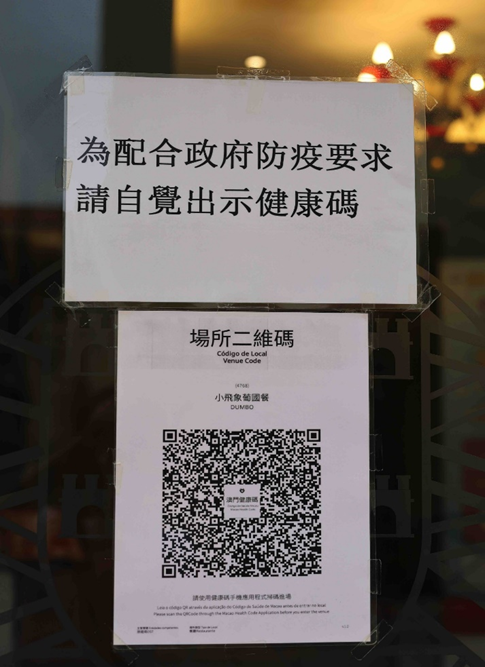
Figure 2 Above - Notice requiring presentation of the location code (in Chinese); Below - Location code displayed at the entrance of Dumbo Portuguese Restaurant (in Chinese, Portuguese, and English) Above - TPB195-1 Below - TPB195-2. Note: The distinct samples present in the same photo were annotated with their own unique labels.
Given the specificity of this research, the collected photos were annotated according to five analytical categories: number of languages, type of languages, dominant language, sign classification, and data collection zone, which constitute variables for the analysis of the current study. The specifics are outlined in Table 2 below.
In order to emphasise the significance of signs containing information on pandemic prevention and control as a component of the linguistic landscape of Macau during the pandemic period, these signs were additionally selected from the constructed corpus for description and analysis.
At the outset of this section, it was indicated that the current study is quantitative and comparative in nature. It should be noted that the treatment of information in this study extends beyond the mere presentation of percentage data. In addition, the Statistical Package for the Social Sciences (SPSS) is employed for statistical analysis, including the chi-square test, in order to determine the relevance of differences in the datasets collected before and during the pandemic.
Next, we present the three questions to which our study seeks to provide answers.
- How do the linguistic landscapes of Macau differ before and during the COVID-19 pandemic, and how are these differences manifested?
- What are the characteristics of COVID-19 signs found in Macau during the pandemic period? This includes their quantity, classification, features in terms of language use, and other relevant characteristics.
- In the multilingual and multicultural city of Macau, were all linguistic communities taken into account in the dissemination of information regarding pandemic prevention and control measures?
3. Results
We begin the comparative analysis of the data relating to the five variables listed in Table 2.
V1. Number of Languages
As shown in Table 3, before the pandemic, 45.5% of the 1391 valid samples were monolingual, 46.5% were bilingual, and 8.0% were multilingual. During the pandemic, 43.6% of the 2859 valid samples were monolingual, 45.4% were bilingual, and 11.0% were multilingual. From this comparison, it can be observed that the percentages of monolingual and bilingual samples did not vary significantly, but there was an increase in multilingual samples.
Table 3 Comparison of monolingual, bilingual, and multilingual data from the pre-pandemic and pandemic periods

χ 2 (2) = 9.65, p = 0.008
A chi-square test of independence was conducted to evaluate the relationship between the variable "Number of Languages" and the variable "Before/During the Pandemic". The association between these variables was considered significant (χ²(2, 4250) = 9.65, p = 0.008), indicating that there are more multilingual signs during the pandemic than before.
V2. Type of languages
Regarding the monolingual data (cf. Table 4), in the pre-pandemic period, there was already an absolute predominance of Chinese use (80.0%), surpassing English (19.0%) as the international language, and even more so Portuguese (0.9%), the other official language of Macau. The data during the pandemic period indicate that this situation has not changed. At the same time, the use of the two official languages (Chinese, 83.8%, and Portuguese, 2.5%) increased, with a relative decrease in English (13.2%), as confirmed by the results of the chi-square test (χ²(3, 1979) = 16.75, p = 0.001).
Table 4 Comparison of monolingual data from the pre-pandemic periods and pandemic in relation to the type of languages

χ 2 (3) = 16.75, p = 0.001
In the comparison of bilingual and multilingual data (cf. Table 5), it was found that before and during the pandemic, the linguistic combinations of Chinese-English, Chinese-Portuguese, and Chinese-English-Portuguese predominated. However, after the pandemic, the combination of Chinese-English (51.7%) and Chinese-English-Portuguese (18.5%) increased, while the Chinese-Portuguese combination (26.8%) decreased. These changes were evidenced by the results of the chi-square test (χ²(10, 2371) = 45.40, p = 0.000). It is supposed that these phenomena are related to the increase in unofficial signs. Furthermore, it was observed that the languages of minority groups present in the data, whether monolingual, bilingual, or multilingual, such as Japanese, Korean, Vietnamese, Filipino, French, Italian, German, etc., are almost always associated with restaurants or shops.
V3. Dominant language
Regarding the bilingual and multilingual signs in Macau, although the percentage values in Table 6 show an increase in the absolute predominance of Chinese from 79.6% before the pandemic to 83.5% during the pandemic, and a decrease in the use of English, the international language, and Portuguese, the other official language of Macau, from 14.9% to 12.5% and from 5.1% to 3.5%, respectively, the results of the chi-square test (χ²(3, 2371) = 7.03038, p = 0.071) indicate that this change was not statistically significant. Therefore, the data related to the dominant language category remained unchanged in Macau's linguistic landscape during the pandemic.
V4. Sign classification
According to the pre-pandemic data from Zhang (2016) (cf. Tables 7 and 8), both official and unofficial samples show consistency in the use of languages in the dominant language category, that is, Chinese prevails in the samples.
Table 7 Comparison of official signs in the data from the pre-pandemic and pandemic periods regarding the dominant language

χ 2 (2) = 21.987, p = 0.000
Table 8 Comparison of unofficial signs in the data from the pre-pandemic and pandemic periods regarding the dominant language

χ 2 (3) = 6.13137, p = 0.105391
Although the pandemic period data show the same characteristics reflected by the pre-pandemic data mentioned in the previous paragraph, discrepancies are found between the data collected in the two different periods. The data presented in Table 7 indicate significant changes in the dominant language observed in official signs during the pandemic period. The results of the chi-square test (χ²(2, 609) = 21.987, p = 0.000) underscore this significance. Specifically, there was a notable increase in the prevalence of Chinese, rising from 89.3% before the pandemic to 97.6%. Conversely, there was a decrease in the use of English and Portuguese, dropping from 2.6% to 0.8% and from 8.1% to 1.6%, respectively. The same is not true for the data pertaining to unofficial signs (cf. Table 8), where the p-value (0.105391) was greater than 0.05. This indicates that the dominant language variable was not affected by the data collection period variable (before or during the pandemic).
Regarding the number and type of languages, the official data show different linguistic use compared to the unofficial data across the two periods. Table 9 illustrates that in the official samples, the combination of the two official languages, Chinese-Portuguese, was predominant with 54.4% before the pandemic and 44.9% during the pandemic. This decrease was offset by a slight increase in the use of the Chinese-Portuguese-English combination (32.7% before the pandemic and 35.5% during the pandemic) and the use of Chinese (4.0% before the pandemic and 8.2% during the pandemic) and Portuguese (0.0% before the pandemic and 3.6% during the pandemic) in monolingual samples. The difference between the data from the two periods was significant, as evidenced by the results of the chi-square test (χ²(7, 640) = 21.74, p = 0.003).
In contrast, in the unofficial data (cf. Table 10), there is a predominance of Chinese in the monolingual samples (43.4% before the pandemic and 41.0% during the pandemic). Additionally, the Chinese-English combination (27.8% before the pandemic and 32.8% during the pandemic) is higher than the Chinese-Portuguese combination (14.4% before the pandemic and 10.4% during the pandemic). In the multilingual samples, the Chinese-Portuguese-English combination stands out (2.5% before the pandemic and 6.4% during the pandemic). Comparing data from the two periods, there is an increase in the Chinese-Portuguese and Chinese-Portuguese-English combinations and a decrease in Chinese-Portuguese. The results of the chi-square test (χ²(14, 3610) = 62.90, p = 0.000) prove that these variations were significant.
Table 9 Comparison of official signs in the data from the pre-pandemic and pandemic periods regarding the number and type of languages

χ 2 (7) = 21.74, p = 0.003
Table 10 Comparison of unofficial signs in the data from the pre-pandemic and pandemic periods regarding the number and type of languages

χ 2 (14) = 62.90, p = 0.000
It was observed that many of the official signs related to the prevention and control of the pandemic appear only in Chinese. This might suggest that the priority was to notify the largest possible number of people, hence the choice of the language understood by the largest group of the population. According to the Global Results of the 2021 Census in Macau (DSEC, 2022), 86.2% of the population speaks Cantonese fluently as a means of communication, 45.0% speaks Mandarin Chinese, 22.7% speaks English, and 2.3% speaks Portuguese. The sociolinguistic situation in Macau is described as multilingualism in Chinese overlapping multilingualism in English and other foreign languages. (Bolton, 1992). Since announcing in two languages involves translation work, a solution could be to opt for the use of Chinese only as a matter of efficiency in time.
V5. Data Collection Zone
It is noteworthy that there are differences in the linguistic configuration between commercial and non-commercial zones, which is supported by the results of the chi-square test (χ²(3, 1576) = 9.96948, p = 0.0188273, and χ²(3, 795) = 9.60966, p = 0.0221929). Tables 11 and 12 illustrate that, in commercial zones, Chinese as the dominant language in bilingual and multilingual signs was further strengthened during the pandemic, increasing from 76.3% to 82.9%. The positions of English and Portuguese weakened, decreasing respectively from 18.7% to 13.6% and from 4.4% to 3.2%. Conversely, in non-commercial zones, there is an observed increase in the prominence of English (5.5% before the pandemic and 10.6% during the pandemic), and a slight decline in the predominance of Chinese and Portuguese (87.6% before the pandemic and 84.4% during the pandemic in the former case, and 6.9% before the pandemic and 4.0% during the pandemic in the latter case).
Table 11 Comparison of signs in commercial zones in the data from the pre-pandemic and pandemic periods regarding the dominant language

χ 2 (3) = 9.96948, p = 0.0188273
Table 12 Comparison of signs in non-commercial zones in the data from the pre-pandemic and pandemic periods regarding the dominant language

χ 2 (3) = 9.60966, p = 0.0221929
This phenomenon is not difficult to explain, given that after the pandemic outbreak, the number of tourists in Macau decreased significantly. Under travel restriction policies, the daily average of tourist arrivals in Macau dropped from over 100,000 in 2019 to about 9,100 in 2020, 21,100 in 2021, and 15,600 in 2022 (Siu, 2023). In light of this situation, commercial activities turned towards local residents, with the Macau government implementing measures to stimulate local consumption and support economic recovery, such as issuing a consumption card to every resident. Therefore, the main consumers in the commercial zone are predominantly local Chinese residents. On the other hand, the non-commercial zone is also inhabited by residents of non-Chinese nationality, making it necessary to convey information about pandemic prevention and control to all residents. As a result, the predominance of Chinese continues to increase in the commercial zone, while in the non-commercial zone there is a slight increase in English as the dominant language.
Furthermore, both commercial and non-commercial zones exhibit similar characteristics to those mentioned in the previous paragraph regarding the number and type of languages in the monolingual data. That is, in the commercial zone, there was an increase in the use of Chinese and a decrease in the use of English during the pandemic, while in the non-commercial zone there was a decrease in the use of Chinese and an increase in the use of English.
On the other hand, regarding the bilingual and multilingual data, signs in Chinese-English increased, while those in Chinese-Portuguese decreased in both commercial and non-commercial zones. The results of the chi-square tests presented in Table 13 (χ²(13, 2686) = 67.01, p = 0.000), and in Table 14 (χ²(12) = 61.63, p = 0.000) confirm the significance of the changes identified in the pandemic data collected in the commercial and non-commercial zones compared to the pre-pandemic data.
Table 13 Comparison of the signs in the commercial zones contained in the data from the pre-pandemic and pandemic periods in relation to the number and type of languages

χ 2 (13) = 67.01, p = 0.000
Table 14 Comparison of signs in non-commercial zones in pre-pandemic and pandemic data in terms of number and type of languages

χ 2 (12) = 61.63, p = 0.000
Having presented the data from a comparative perspective, we now focus our study on the signs linked to the prevention and control of the pandemic, collected during the pandemic period.
As shown in Table 15, the samples in question total 167, representing 5.8% of our entire corpus, with 53.9% being health location codes posted at the entrances of public services, schools, businesses, shops, restaurants, hotels, and other public spaces. Figure 3 is a health code that had to be presented by everyone entering a business named XCB EXPOSIÇÃO LIMITADA. It is important to highlight the presence of spelling errors in the company name: what is listed as XCB ESPOSICAO LIMITADA.
Additionally, 41.3% of the data correspond to announcements or notices (cf. Figures 4 and 5) that request the presentation of a health code, the wearing of masks, or temperature checks, while 4.8% are posters or banners to promote cleaning, sterilization, and vaccination (cf. Figures 6 and 7).
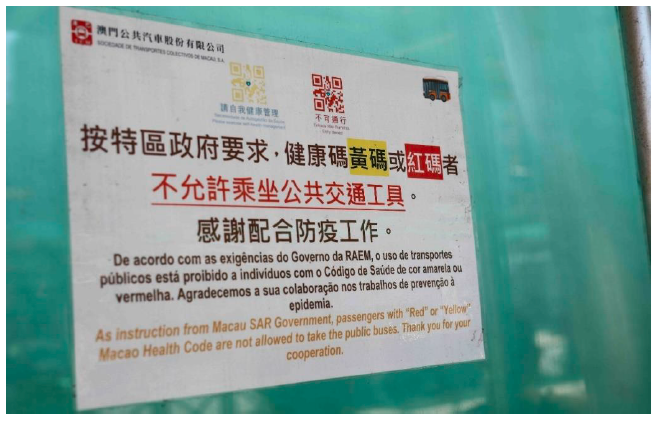
Figure 4 A notice posted at a bus stop prohibiting the use of the bus by people with a yellow or red health code (in Chinese, Portuguese, and English) | GZM299
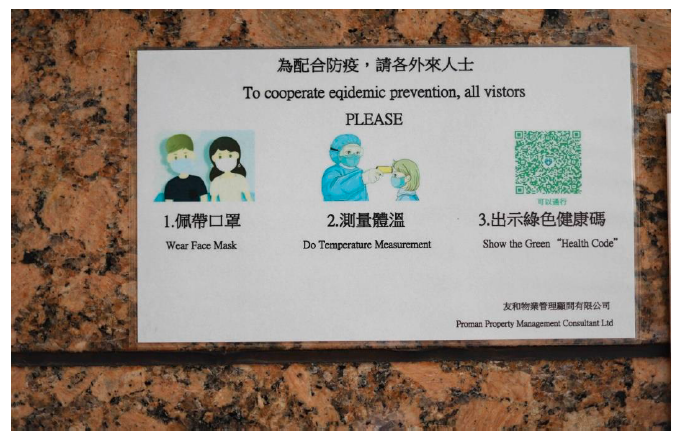
Figure 5 A notice posted at the entrance of a residential building requesting non-residents to wear masks, measure temperature, and present a health code (in Chinese and English) | TPM091
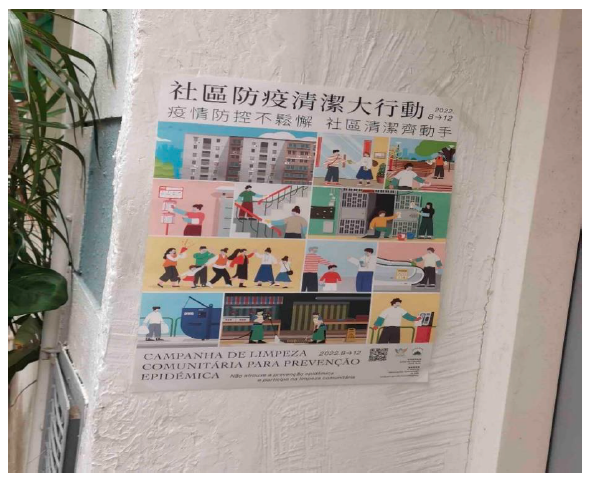
Figure 6 A poster posted at the entrance of a private house to promote a community cleaning campaign for pandemic prevention (in Chinese and Portuguese) | CLB028
Regarding the languages used, there are more official signs than unofficial ones, and a difference in language utilization between them is observed (Table 16). In the first group, the Chinese-Portuguese combination, the two official languages of Macau (45.5%), and their combination with English (19.6%) stand out. The predominance of Chinese is absolute, as nearly all official signs contain this language. The only exception is a sign solely in English. It is worth noting that the discovery of the use of Japanese, French, and Italian languages, although in very small quantities, highlights the Macau government's consideration for speakers of these languages. On the other hand, the use of languages in unofficial signs is different. The use of Chinese (54.6%) is more frequent, while the combinations of Chinese-English and Chinese-English-Portuguese account for 20.0% and 18.2%, respectively.
Tabele 16 Type of languages in official and unofficial post-pandemic data related to pandemic prevention and control

Upon analysing the data, it is evident that the Macau government placed significant emphasis on pandemic management and assumed primary responsibility for the work of epidemic prevention and awareness (Wang & Liu, 2022), having taken serious measures to prevent its spread within the community. Macau, being the most densely populated region in the world with a population of 670,000 and a population density of 21,717 people per km², receives up to 38 million tourists per year. Therefore, ineffective control of infectious diseases could be catastrophic (Ieng and Cheong, 2020). In this process, the government complied with the legislation on the use of languages, that is, the use of the two official languages in government-issued documents. Moreover, private organizations and institutions were also involved in the relevant work. As Wang and Liu (2022) noted, the success of Macau's fight against the pandemic would not have been possible without the high level of support from its citizens.
Half of the unofficial signs are solely in Chinese, indicating that the majority of attention is focused on the local population, which is predominantly Chinese. However, the use of English is notable, reflecting that unofficial signs were also designed with non-Chinese residents in mind.
Table 17 Type of languages in pandemic data collected in commercial and non-commercial zones regarding pandemic prevention and control

Table 17 provides information on the type of languages in pandemic data collected in commercial and non-commercial zones, related to pandemic prevention and control. When comparing the data, it is observed that both groups highlight the Chinese-Portuguese combination (29.9% in commercial zones and 36.7% in non-commercial zones). The use of Chinese (28.0%) and the Chinese-English combination (23.4%) in the commercial zones' data is more pronounced than the same languages in the non-commercial zones' data (21.7% and 11.7%). In contrast, the Chinese-English-Portuguese combination is more prevalent in the non-commercial zones' data (25.0%) than in the commercial zones (15.9%). This corresponds to what was mentioned in the comparison of pre-pandemic and pandemic period data, that is, linguistic use in commercial zones is more closely linked to the commercial activities that occur there.
Before concluding the analyses, we present information on the dominant language in bilingual and multilingual data in Table 18.
Once again, there is an absolute predominance of Chinese, which is the dominant language in 97.5% of the bilingual and multilingual data. Messages issued by both the government and private organizations and institutions were targeted at the local society of Macau, which is primarily composed of Chinese speakers.
4. Discussion
Revisiting the three research questions previously raised, our study initially compared data on the linguistic landscapes of Macau before and during the pandemic. The results reveal significant differences between the two datasets. In monolingual samples, we noted a slight increase in the use of Chinese and Portuguese, while in bilingual and multilingual samples there was an increase in Chinese-English and Chinese-English-Portuguese combinations and a decrease in the use of the Chinese-Portuguese combination. This suggests that one of the impacts of the pandemic is the increased use of Chinese as the native language of the majority of Macau's residents, which is also reflected in the growth of Chinese as the dominant language and the weakening of English and Portuguese as dominant languages in official signs. Additionally, changes in language use in signs in commercial and non-commercial zones are distinct. In commercial zones, there is a greater reinforcement of the predominance and use of Chinese, while in non-commercial zones there is an increase in the use of English. These changes are intrinsically related to the impact of the pandemic on Macau's society, especially demographic changes. Due to the entry and exit restrictions of border policy during the pandemic, there was a sharp reduction in the number of tourists (Siu, 2023), an economic recession, the departure of many non-local workers from Macau, and the decision of many Portuguese to permanently return to Portugal. All this culminated in the evident increase in the predominance of the Chinese language across all data. However, we also observed an increase in multilingual samples in Macau during the pandemic period, indicating the continuity of linguistic diversity in Macau, reflecting the behaviour of the Macau government and local communities with a multilingual awareness.
Secondly, the quantity, content, and characteristics of the signs associated with COVID-19 were analysed, since public signs have been widely used for messages related to COVID-19, most likely due to the profound impact of the pandemic on our perception and use of public space. (Kalocsányiová, Essex & Poulter, 2023). The samples refer to the health code posted at the entrance of public spaces by the Macau Government, as well as notices, posters, or advertising banners related to the requirements of governmental and private organizations and institutions regarding mask-wearing, temperature measurement, presentation of the health code, maintaining social distance, vaccination, frequent hand washing, and community cleaning. However, there is scarce or no published information about other important measures (including staying at home and/or self-isolation and the restriction of unnecessary travel and movements). Within this set of samples, Chinese emerges as the absolutely dominant language. The Chinese-Portuguese combination is more frequently employed in official signs, while Chinese predominates in unofficial signs. The Chinese-Portuguese combination appears in the greatest number of signs, both in commercial and non-commercial zones. It is worth noting that Chinese is also present in a relatively high proportion in signs in commercial zones. These data indicate that non-governmental organizations and institutions were less affected by the language policy of the Macau government in disseminating pandemic-related messages. This corroborates what Reh (2004) points out, indicating a discrepancy between language policy and the actual situation of language use.
Additionally, regarding the data relevant to the pandemic, some sporadic information appears in Japanese, French, and Italian. However, none of it relates to the languages of non-resident workers. As indicated by the Macau Statistics Services (2022), this group predominantly consists of individuals from the Philippines, Vietnam, Indonesia, etc., accounting for 8.8% of the total population. During the pandemic, "the resident population was protected, but the same was not true for the non-resident population, which makes up a large part of Macau's workforce and suffered greatly" (Branco, 2022:67). Although symbols and images often provide essential visual explanations, some content for guidance or instruction was inaccessible to people with limited reading skills in English. Furthermore, these individuals rely heavily on public transport and reside in densely populated areas, complicating the maintenance of physical distance and self-isolation. All these factors contribute to an increased risk of contracting COVID-19. It was observed that the unique circumstances of this particular group were not taken into account during the dissemination and distribution of pandemic-related information.
Conclusion
In summary, by analyzing and comparing the linguistic landscapes of Macau before and during the pandemic, this study illustrates how the linguistic environment of a region evolves alongside societal developments. Particularly, it highlights the impact of a prolonged "public health emergency" like the COVID-19 pandemic, which led to significant shifts in the demographic composition of the local community in Macau.
Author contributions
Conceptualization, J.Z. and J.Z.; data curation, J.Z. and J.Z.; formal analysis, J.Z. and J.Z.; investigation, J.Z. and J.Z.; methodology, J.Z. and J.Z.; project administration, J.Z. and J.Z.; supervision, J.Z. and J.Z.; validation, J.Z. and J.Z.; visualization, J.Z. and J.Z.; writing-original draft, J.Z. and J.Z.; writing-review and editing, J.Z. and J.Z.















